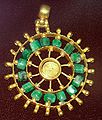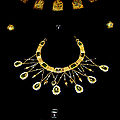Varna Archaeological Museum
The Varna Archaeological Museum (Bulgarian: Варненски археологически музей, transcription: Warnenski archeologitcheski musej) is an archaeological museum in the city of Varna on the Bulgarian Black Sea coast . The traditional museum, which is one of the oldest museums in Bulgaria , was founded in 1887 by the brothers Hermann and Karel Škorpil .
Exhibitions
Among the most spectacular exhibits include the gold additions from the Copper Age from the cemetery of Varna in the west of the city, in which the world's oldest processed gold was found in 1972, which dates back to between 4600 and 4200 BC. Was dated. This globally unique European Varna culture , which was technically so advanced during the Copper Age that it could mine and process gold, was named after the place where it was discovered.
The collections are divided into the following subject areas and epochs:
- Hall 1: Paleolithic (Paleolithic) and Mesolithic (Middle Stone Age): up to the 8th millennium BC Chr.
- Hall 2: Eneolithic (Copper Age): 5th millennium and second half of the 5th century BC Chr.
- Hall 3: Thracian Art : 3200 BC Until 500 BC Chr.
- Hall 4 to 7: Copper Age necropolis of Varna : 4400 to 4200 BC Chr.
- Hall 8: The founding history of Odessos : 6th to 4th century BC Chr.
- Room 9: Odessos during the Hellenistic period: middle of the 4th century BC Until the middle of the 1st century BC Chr.
- Rooms 10 to 12: Religion and burial rituals: 1st to 4th centuries
- Room 13: Jewelry: 4th to 6th centuries
- Rooms 14 and 15: Odessos during the Roman period: 1st to 3rd centuries
- Room 16: Ancient Art: 5th Century BC BC to 3rd century AD
- Room 17: Odessos and its surroundings in late antiquity: 4th to 7th centuries
- Hall 18: early Christian Odessos : 4th to 7th century
- Rooms 22 to 23: The Varna region during the First Bulgarian Empire : 7th to 11th centuries
- Room 24: The rebirth of urban life in Varna :
- Room 25: Varna during the Second Bulgarian Empire : 12th to 14th centuries
- Room 26 to 28: Varna between the 14th and 18th centuries: 14th to 14th centuries
- Room 29: Medieval jewelry: 13th to 14th centuries
- Room 31: Sacred devices from the 17th to 19th centuries: 17th to 19th centuries
- Room 32: Icons from the 16th to 18th centuries: 16th to 18th centuries
- Room 33 to 34: Icons from the Bulgarian Black Sea coast: 19th century
- Room 35 to 36: Icons by the icon painters of the so-called Trjawna School (bulg.тревненски зографи): 19th century
- Room 35 to 36: Carving of the so-called Trjawna School (bulg.тревненски майстори): 19th century
literature
- Manfred Oppermann : Thracians, Greeks and Romans on the west coast of the Black Sea . Zabern's illustrated books on archeology . Zabern, Mainz 2007, ISBN 978-3-8053-3739-7 .
Web links
- Official website of the museum (English, Bulgarian)
Coordinates: 43 ° 12 ′ 27 ″ N , 27 ° 54 ′ 54.1 ″ E







